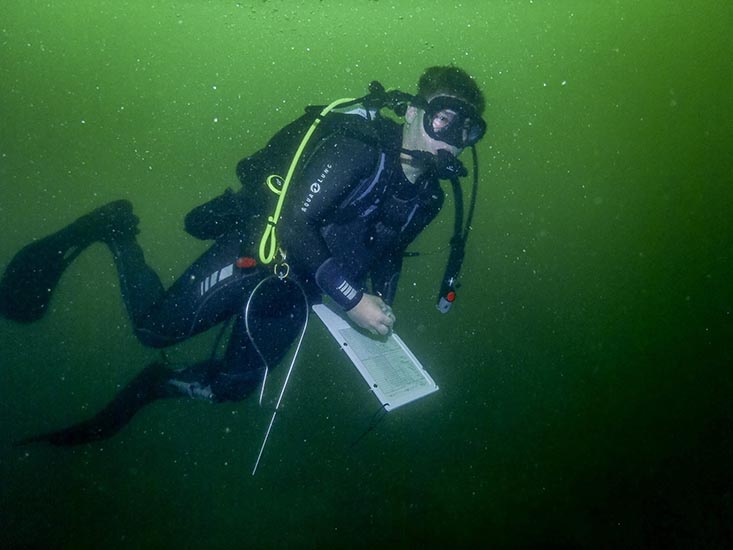Written by Kristen Kusek, Former Communications Director for USF CMS
It’s easy to find a fisherman in Florida wearing a shirt with the likes of a spotted seatrout, snook, or tarpon sporting that iconic acrobatic pose. (You know the one.) After all, these are the prized gamefish that lure people to the Sunshine State from all over the world – earning respect as they fill dinner plates, bank accounts, and yes, a few tall tales.
But if Jon Peake, graduate student at the USF College of Marine Science, had it his way, there would be gear aplenty that also celebrates the little guys -- the silversides, anchovies, and pinfish. These are the Davids that fill the bellies of the Goliaths, and those of seabirds and mammals as well.
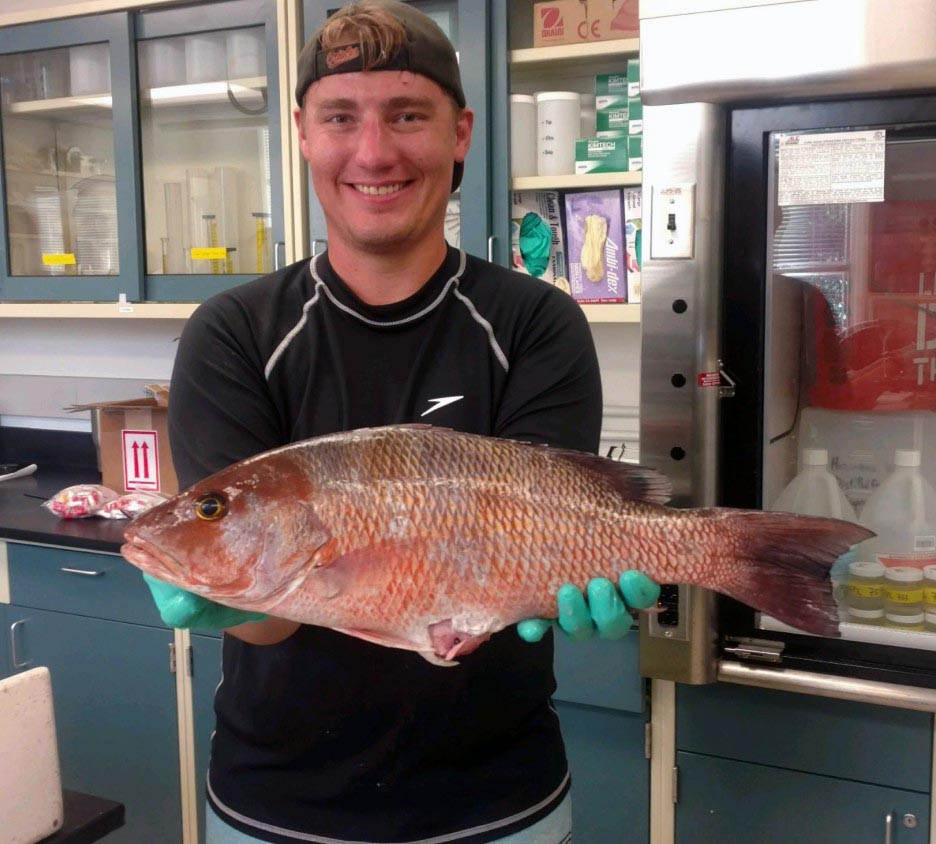
Jon Peake in the lab with an impressive gray snapper, just one of many prized gamefish that lure people to the Sunshine State.
Forage fishes, or bait fish, are unsung heroes of the Gulf coast ecosystem. Many of these species have been overlooked by fisheries scientists and managers until fairly recently, said Peake. For example, basic ecological questions such as how forage fish communities are structured, which environmental factors influence which species live where, and how the communities shift over time remain unsolved mysteries, especially in coastal environments.
“The studies that have been done on forage fishes have focused on more pelagic (open ocean) systems, with just one or two species taken into account,” said Peake. “But it’s essential that we understand their community dynamics in highly productive estuarine environments because they are critical to sustaining those economically important, bigger fish.”
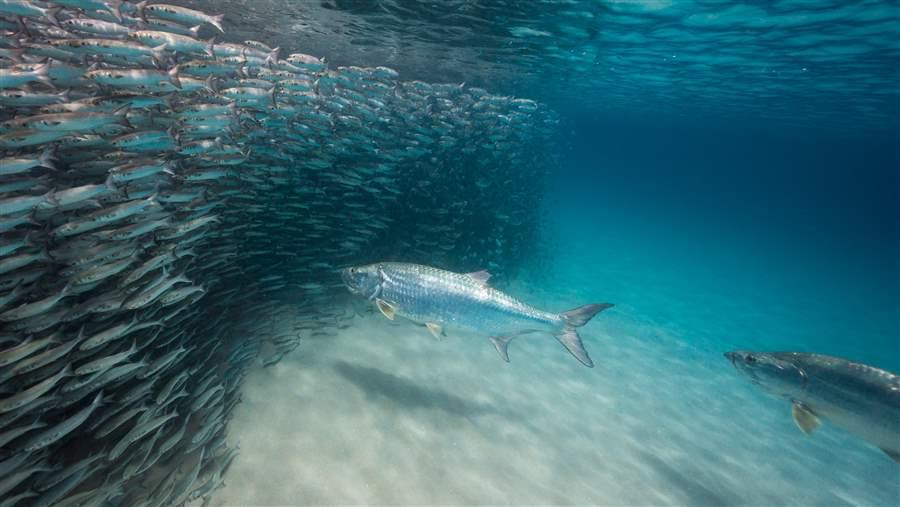
Forage fishes, or bait fish, are unsung heroes of the Gulf coast ecosystem. Many of these species have been overlooked by fisheries scientists and managers until fairly recently. Credit: Paul Dabill (pewtrusts.org)
Peake recently led a unique (and uniquely hefty) study published in Ecosphere that helps fill in some of the research gaps. It included a whopping 50 species of estuarine forage fishes distilled from a 30-plus-year database maintained by the Florida Fish and Wildlife Conservation Commission’s Fish and Wildlife Research Institute (FWRI).
FWRI’s Fisheries Independent Monitoring (FIM) group, where Peake now works as he finishes his dissertation, has been collecting these data since 1989 to monitor populations of juvenile and adult sport fishes across Florida’s estuarine ecosystems. But FIM’s unofficial motto of “collect all the data, all the time” lends itself to studies of non-target species as well. This particular study focused on 20 years of data collected from 1998-2017.
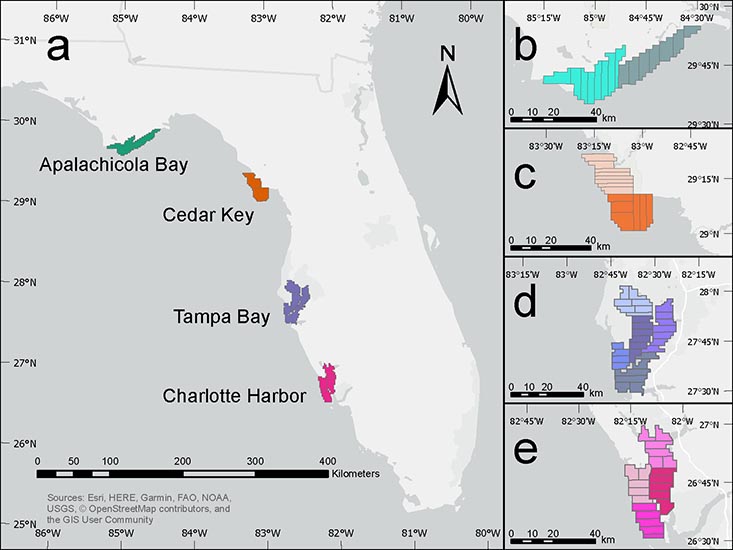
Map of the sampling areas in the eastern Gulf of Mexico: two northern estuaries (Apalachicola Bay and Cedar Key) and two southern estuaries (Tampa Bay and Charlotte Harbor).
Peake performed a series of multivariate analyses, which allow researchers to examine the composition of ecological communities as a whole rather than on a species-by-species basis. These allowed him to compare forage fish communities in four estuaries in the Gulf of Mexico: two northern estuaries (Apalachicola Bay and Cedar Key) and two southern estuaries (Tampa Bay and Charlotte Harbor).
“It was definitely a computationally complex study,” said Peake, who enjoys catching fish in the field as much as he enjoys distilling big datasets on a computer.
“Forage fishes are an incredibly important component of marine food webs,” said Chris Stallings, senior author on the publication and Peake’s graduate advisor. “Jon has extended the classic work on their dynamics in shelf ecosystems to those in highly productive estuaries.”
While his approach in using multivariate analyses to study such a high number of forage fish species at once was novel, what he found was “more of a confirmation of what we thought based on ecological theory,” said Peake.
One key take-away: Peake was able to identify clear patterns that show which species of forage fishes live where, and how they vary seasonally. In short, the species in the two northern (warm temperate) estuaries, such as the bay anchovy, menhadens and rough silverside, are more planktonic in nature; they eat tiny plants and animals in the water column. Those in the two southern (subtropical) estuaries, such as pinfish and pigfish, rely more on the benthic community, such as seagrasses and algae living on the bottom.
Peake said that’s what you’d expect: the northern estuaries are subject to higher nutrient fluxes and greater river discharges that make it hard for seagrasses to thrive, whereas the southern estuaries exhibit higher water clarity and salinity that are conducive to seagrass growth.
“The significant role the rivers play in driving the estuarine input, and therefore the community structure of the forage fishes, was a bit surprising to us,” said Peake, who spent two years working up the results.
The analyses were not without challenges. A big one he encountered was how to aggregate the different gear types used to sample fish – seines near the shoreline and trawl nets used in open water areas -- in a way that didn’t bias the dataset.
“I found a way to standardize it but yes, that was a snag that took me an extra couple months to figure out,” Peake said. (Side note: This study isn’t even part of Peake’s dissertation research at USF; he calls it a fun side project.)
“Impressively, Jon overcame several analytical challenges with this large dataset that included a method of standardizing across sampling gear that will be useful in future studies,” said Stallings. Vital to Peake’s success, he said, was his discovery of a publication by a team led by Gibson-Reinemer, a scientist at Adams State University in Colorado, that details a method called Multigear Mean Standardization.
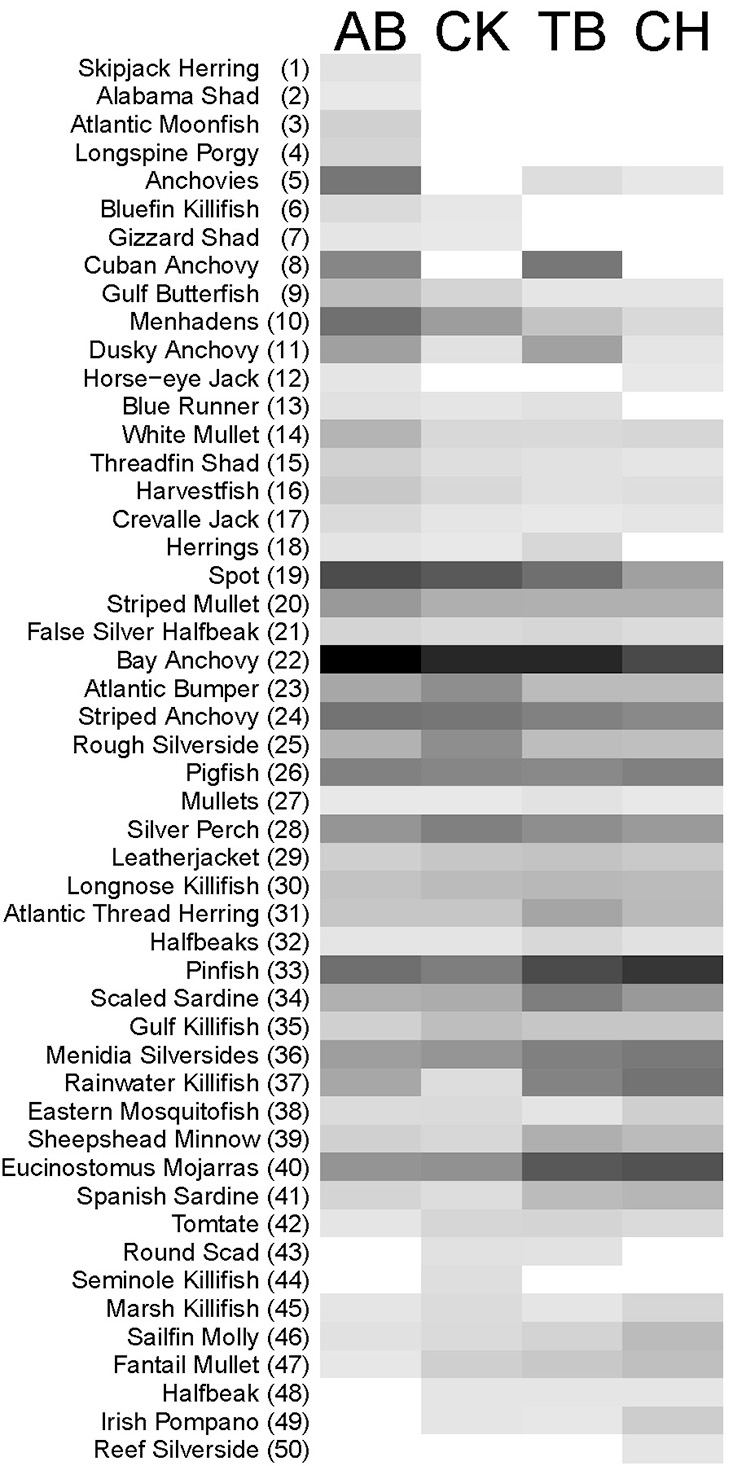
Distribution of forage fishes across all estuaries: AB=Apalachicola Bay, CK=Cedar Key, TB=Tampa Bay, CH=Charlotte Harbor. The bay anchovy (22) were the most abundant, and the pinfish (33) were most ubiquitous.
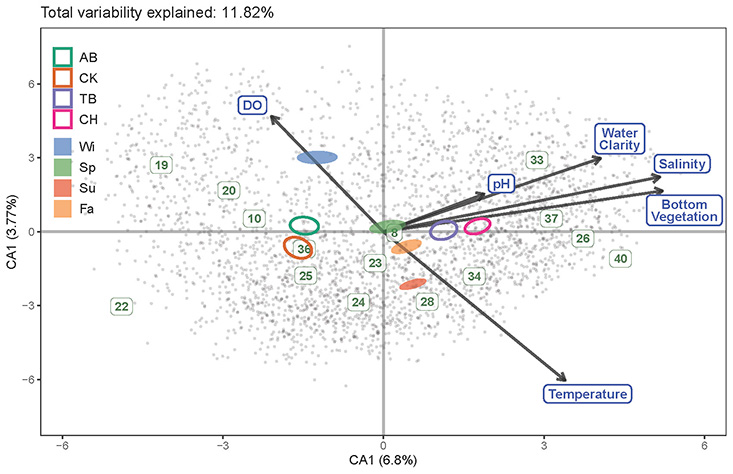
Habitat associations by estuary (AB, CK, TB, CH) and season (Wi=winter, Sp=spring, Su=summer, Fa=fall). Forage fishes are represented as numbers that correspond to the numbers on the gray-scale chart above.
“This study was based on observational data – it wasn’t a true experimental study -- but it does offer us a dynamic snapshot in time,” said Peake.
“The results serve as a cautionary tale,” said Peake. It’s important for scientists to continue studying these communities so they can help predict how changes in estuarine water quality, for example, could propagate through the system.
For example, the Indian River Lagoon, an estuary on Florida’s east coast, used to be a thriving benthic system and “one of the best seatrout spots in the country,” said Peake. But nutrient runoff drove it toward a more planktonically dominant habitat – less seagrass and more mud. In time, the entire system was completely barren of seagrasses, Peake said. And that spells heartbreak to a fisherman: you can catch plenty of catfish and stingrays but far fewer seatrout.
“We do not want that kind of change to occur here on the Gulf coast,” said Peake. “Any decrease in water quality, which could mean less seagrass, would pose a huge risk to iconic species such as snook, which overwhelmingly eat pinfish that live in those seagrasses.”
Funding for this work was provided by fellowship donations to the Florida Forage Fish Coalition that includes the International Game Fish Association, Pew Charitable Trusts, Wild Oceans, American Sportfishing Association, Florida Wildlife Federation, and the Angler Action Foundation.
